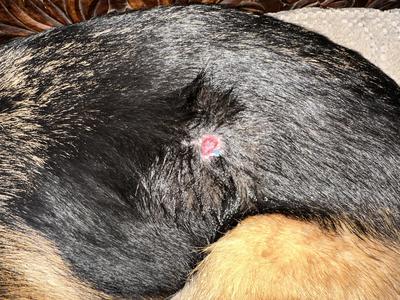Unidentified Skin Ulcer on Side - Causes and Treatment Options
by Jenny
(Canberra ACT Australia)
Reader Question: Causes, Identification and Treatment of a Dog Skin Ulcer on Side
I just found this 20 cent piece size wound/ulcer on my dogs side.
I don’t recall any other dog biting her.
No idea what caused it or what it is.
Editor Response - Possible Causes and Treatment Options for a Dog Skin Ulcer on Side
Hi Jenny,
Thanks for sharing the photo of your dog's wound and sorry to hear about the skin problem. From the image, it appears to be a raw, circular area with some central crusting, possibly indicating some healing has begun. The surrounding skin looks a bit irritated but not excessively inflamed.
List of Possible Causes and Related Treatment
Localized Dermatitis or Abrasion: The wound could be a result of minor trauma like an abrasion against a rough surface. It could also be an area of localized dermatitis where the skin has become irritated and subsequently broken down.
Action: Keep the wound clean by gently washing it with a mild dog-friendly antiseptic. You can apply a thin layer of a pet-safe antibiotic ointment. Ensure your dog doesn't lick the area; consider using a protective collar if necessary. Monitor the wound closely for signs of healing or any worsening, such as increased redness, swelling, or discharge.
Insect Bite or Sting: It's also possible that
Action: You can treat the area with a cold compress to reduce swelling and irritation. If you notice any signs of allergic reaction, such as hives or facial swelling, or if your dog seems to be in distress, seek veterinary care immediately.
Foreign Body Reaction: Occasionally, a wound like this can be caused by a small foreign body (like a thorn or splinter) that has penetrated the skin and caused a local reaction.
Action: Examine the wound carefully to see if you can identify any foreign material. If you do find something embedded, and it's easily removable without causing pain or distress, you may gently attempt to remove it. However, if it's not easily accessible, or if doing so causes your dog discomfort, a vet should perform the removal.
Please keep a close eye on the wound. If there is no improvement within a few days, or if it seems to be getting worse at any point, it would be best to have your vet take a look. They can provide a more definitive diagnosis and may prescribe treatment such as anti-inflammatories or a more specific topical medication.
Wishing your dog a quick recovery!
Warm regards,
Jeff
Editor and Publisher
Dog Health Guide
Join in and write your own page! It's easy to do. How? Simply click here to return to Skin.


